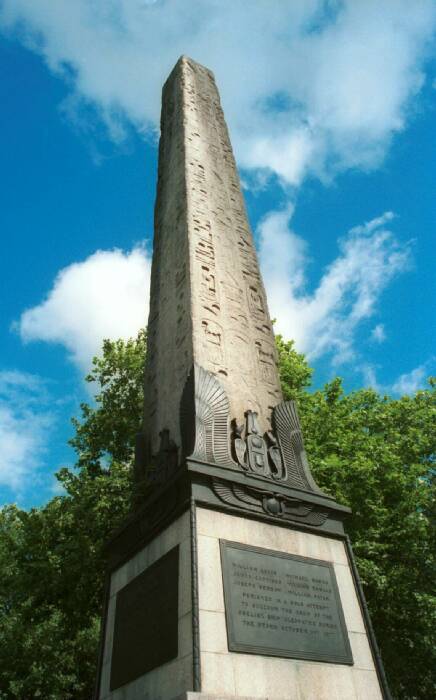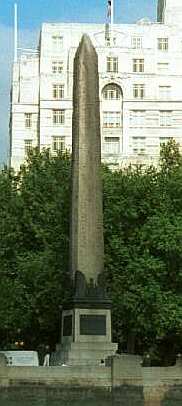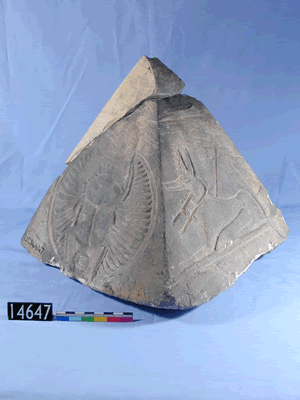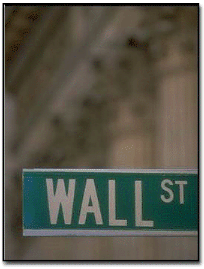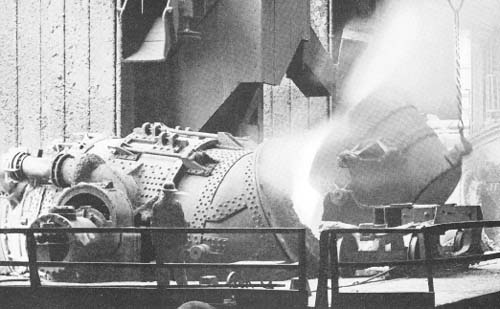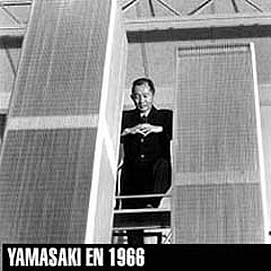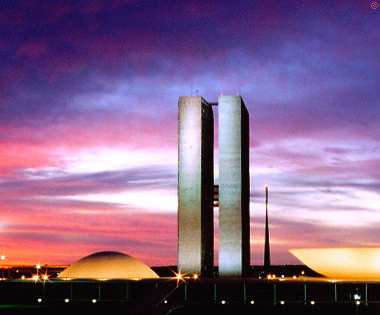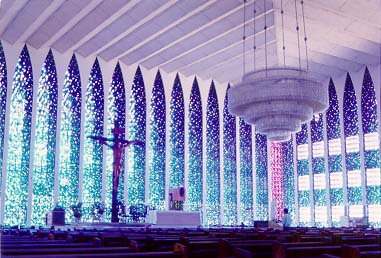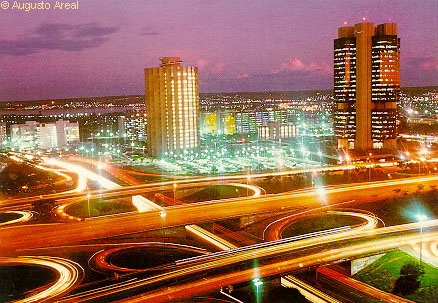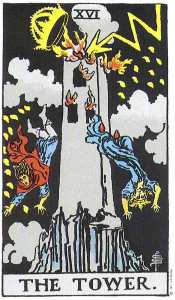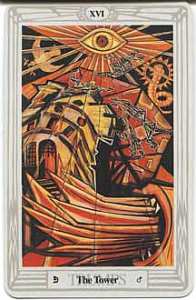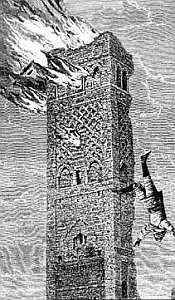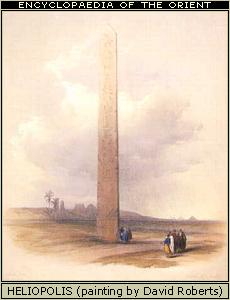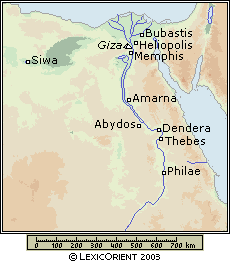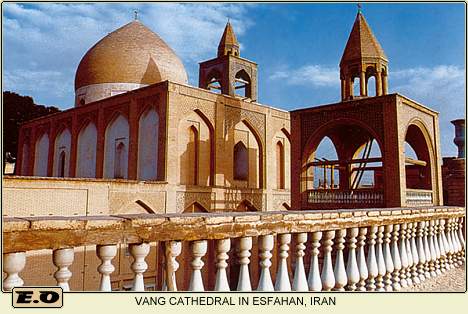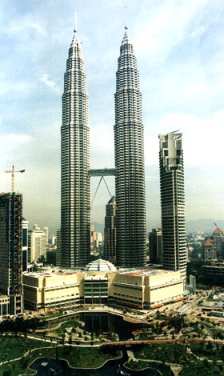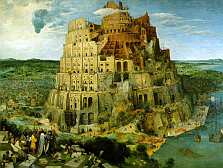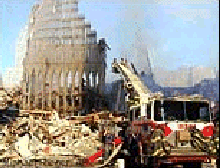|
The skyscraper is an inhabited power symbol derived from the monolith / needle / obelisk
Form & function = perfection
Ingraining secret symbols of power into civic design...
ziggurat, pyramid, tower of babel,
[think...ivory tower metaphor]
|
|
|
history of egyptian needle
First erected in Egypt, by Pharaoh Thotmes III around 1500BC, Cleopatra's Needle was given as a gift to the British people in 1819, in recognition of Admiral Nelson's victory over the French fleet, at the Battle of the Nile in 1798.
Opposite the Victoria Embankment Gardens, on the river front, Cleopatra's Needle is flanked by magnificent bronze lions. The 68 1/2 ft. monolith sits on a pedestal containing various momentous objects including: standard foot and pound, a full set of British Empire coins, Bibles in various languages, a railway guide, an almanac, and copies of contemporary newspapers
"Cleopatra's Needles" is the name given to two Egyptian obelisks, formerly at Alexandria. One of these obelisks now lies in New York, the other in London.
They are made of the rose red granite of Syene, and were originally erected in front of the great temple of Heliopolis, where Moses was born.
The obelisks were taken to Alexandria shortly before the commencement of the Christian era after the death of Cleopatra, but possibly in pursuance of a design originated by her.
The New York obelisk was presented to America by the Rhedive of Egypt, and was set up in Central Park in 1881.
http://www.travellondon.com/templates/attractions/cleopatra.html
|
|
control towers
Cleopatra's Needles were among the first obelisks in the world, created in Egypt during the 400 years of Israel's captivity.
The pyramid on the original seal was actually a step-pyramid, ziggurat (viz. Tower of Babel). It's steps represent the secret societies and religions of man. The top of the pyramid is the highest, most secret position, secret to all the lower levels, secretly passing down its dictates. The only thing higher in this chain of command is the
great architect himself, symbolized in the all-seeing eye, the capstone, hovering above the pyramid tower, showering light upon all the building blocks (initiates) below.
|
|
The top, or capstone of a pyramid.- a 'pyramidion is the apex stone of a pyramid at the top of a column'.
Is it the Headstone and Chief Cornerstone rejected by the builders and symbolized by two obelisks called 'Cleopatra's Needles'?
One of these needles stands on the Thames Embankment, London, and the other in Central Park, New York." (THE MYSTERY OF CLEOPATRA'S NEEDLES, by Evelyn Janes)
Cleopatra's Needles are two great stone pillars from Egypt called obelisks. The obelisks of red granite were cut from a single piece of stone and engraved with picture writing called hieroglyphics. These pillars bear the names of two Egyptian kings, Ramesses and Thutmose III. Some of the obelisks stood before the ancient temple of the sun at Heliopolis, where they were originally erected by Thutmose III. The Romans moved a pair to Alexandria in 14 B.C. It was at this point the title Cleopatra's Needles became attached to them.
In the Bible Heliopolis is called the City of On (the City of the Sun). The grandfather of Ephraim and Manasseh, from which we are descended, was the great high priest of Ra at the ancient Temple of the Sun, in the city of On.
When Ephraim and Manasseh visited their grandfather they probably stood between the two pillars as he patted them on the head. Is it a coincidence that the U.K. (Ephraim) and the U.S. (Manasseh) are now in possession of these ancient obelisks which confirm their Egypto-Israel heritage?
The twin obelisks were presented to the United States and Great Britain during the 1800's. One stands in Central Park in New York City and one on the bank of the Thames River in London. The one in York City stands 69 ft. high and, it is 7 1/2 feet at the base, and weighs 200 tons (Londons is almost identical).
adapted from
http://artoutsider.com/towers.asp
|
|
|
Obelisks in London / New York
Originally, this is one of 9 obelisks at least [2 in Heliopolis, 7 in Karnak], which were erected by Tuthmosis III. In about B.C. 12, Romans had moved 2 obelisks in Heliopolis to Alexandria. Other source says that Octavianus (the first Roman Emperor Augustus [reigned B.C. 27 - A.D. 14]) has moved it in about B.C. 23. But I think this would be an wrong information. In anyway, they (a pair of obelisks) were erected in front of the Caesarium Temple at Alexandria. But the one of two obelisks fell in an earthquake in 1301 A.D., and nearly being lost at sea. Although the "fallen one" was transported to London in 19th Century, but the remained one was the one which was transported to New York later. Therefore, there is nothing in Alexandria at present.
Both these obelisks, which were once in Alexandria, are called "Cleopatra's Needle". Here is a story on Cleopatra's Needle in London.
The story for Cleopatra's Needle in New York begins when the Suez Canal was opened in 1869. As the appreciation for the aid of the construction of the Suez Canal, the ruler of Egypt, the Khedive Ismail Pasha, offered the United States to present an obelisk. However, at the beginning, the Americans did not show the interest in this favorable proposal. But when they knew the Obelisk would be transported to London in 1877, they also began to have an Obelisk, and started the negotiations. 2 years later, they got an authorization from Egypt for transportation, in 1879.
Henry H. Gorringe, a lieutenant commander of the U.S. Navy (Note), was appointed the task of transporting the Obelisk and its pedestal to New York. After a lot of difficulties, the obelisk and its pedestal arrived at the quarantine station of New York Port on July 20th 1880. It took 32 horses hitched in 16 pairs to drag the 50-ton pedestal alone through the streets of the city. Once the pedestal was in place on the small hill in Central Park, the obelisk was then hauled through Manhattan. It took 112 days and arrived at the site on January 5th, 1881. The speed was at the rate of 97 feet a day.
|
|
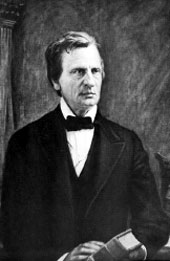
William Maxwell Evarts |
The opening ceremony was held on February 22, 1881, before more than 10,000 jubilant New Yorkers. William Maxwell Evarts, then U.S. Secretary of State, asked to the crowds, "Who indeed can tell what our nation will do if any perversity is possible of realization; and yet this obelisk may ask us, 'Can you expect to flourish forever? Can you expect wealth to accumulate and man not decay? Can you think that the soft folds of luxury are to wrap themselves closer and closer around this nation and the pith and vigor of its manhood know no decay? Can it creep over you and yet the nation know no decrepitude?' These are questions that may be answered in the time of the obelisk but not in ours."
Inscriptions: On each side of each pyramidion (top triangle of the obelisk), Tuthmosis III is drawn as a "sphinx" making offerings to the Gods of Heliopolis. On each side of the obelisk are inscribed with hieroglyph of three columins. The central column is carved by Tuthmosis III, and subsidiary columns both sodes are added by Ramses II. Although the hieroglyph is almost impossible to read it due to the heavy damage, it is said the central column states "the pyramidion illuminates the town of Heliopolis".
http://members.aol.com/Sokamoto31/ny.htm
|
Obelisks for an imperial cult
The obelisk enacts the same formula as the pyramid - maximum height for minimum base - but in different material, leading to different scale and architectural setting.
Obelisks were categorised by the ancient Egyptians themselves according to their scale; txn wr 'great obelisk' or txn aA 'major obelisk' was the term for the giant monoliths for which Egypt is famous, distinct from the smaller obelisks found at lesser shrines and at tomb-chapels, and on miniature scale as amulets.
The tip of the obelisk might be covered in shining metal - gold or the gold-silver alloy electrum; this would catch the first ray of the sun just before dawn, dramatising the illuminating and life-giving power of the creator. These effects are specified in the inscriptions of New Kingdom obelisks, which also make clear the intimate relation of king and sun-god
|
|
|
|
Vatican Obelisk
Augustus and the early Roman Emperors used the obelisk for their own new imperial cult: Augustus had obelisks moved from Iunu/Heliopolis to Alexandria, and an obelisk set up at the centre of a vast sundial, aligned with his own tomb where there was also an obelisk; the whole complex presents a remarkable fusion of Pharaonic and Roman architectural and engineering design, for the new solar rulers of the Mediterranean world. The Roman Emperors commissioned the first obelisks since the Twenty-sixth Dynasty. The Vatican Obelisk now in the square in front of St Peter's in Rome bears no hieroglyphic inscription, and the date of its creation is unknown; it may have been commissioned by Augustus for Alexandria, before being moved and set up in the stadium known as the Circus Vaticanus under the emperor Caligula (AD 37-41). The latest ancient inscription on an obelisk is on the smallest of the giant obelisks, at 9.25 metres; this was set up under the emperor Hadrian at the temple of his lover Antinous in Rome (after the death of Antinous in AD 130). The imperial Roman fascination for obelisks resulted in the erection of a dozen large and small examples in the city; these played a large part in stimulating interest in Egypt from the Renaissance onwards.
digital egypt
|
|
PRINCIPLES AND THEORIES OF ARCHITECTURE
The monolith - as an architectural element - (think of Neolithic standing stones or obelisks) - symbolises this centre-ing - [need to have a place in the world]. It can also symbolise the vertical sacred dimension - the axis mundi - connecting the cosmic realms. Such architectural elements - while enclosing no, or little, space in themselves - define space through radiance. Examples; the minaret, the obelisk, the church tower , the Tempietto by Bramante (1444-1514) at St. Pietro in Montorio (1502).
The power of the monolith - Sixtus V and Baroque Rome
Shows well the power of the monolith within an overall conception to command space over a vast area and centuries in time. Before his death in 1590 Sixtus V imposed an image of order on the chaos of medieval Rome by the location of Egyptian obelisks at key points to define the principal places of pilgrimage (such as the churches of Santa Maria Maggiore and St Giovanni in Laterano) and the movement systems between them. This basic structure provided the armature for the development of Baroque Rome.
Threefold Space
In his book Architectonic Space (1983) the monk-architect Van der Laan characterizes these transitions - from one domain to another - with the notion of Threefold Space: three zones of diminishing intimacy:
THE CELL - the place to be - to study
THE COURT - the space to walk and to contemplate
THE DOMAIN - the wider prospect.
[Below - civic design based on religious identity]
nbsp;
|
|
Esfahan, Iran: Courtyard and City
Because of the importance of privacy in Islam, the demarcation of public-private realms is well-articulated in the Islamic City. The lecture demonstrates the clear hierarchy of primary - secondary and tertiary movement systems which lead to the inward-looking courtyard house - the basic cell of the urban tissue.
Off the bazaar-spine lead smaller lanes which serve the residential quarters.
From these, cul-de-sacs give access to groups of courtyard houses.
lecture
|
Compare to civic structure in wasp countries US UK etc
Social-civic-behavioral engineering...
Work / leisure / shopping / car / consumer driven society...
Career / family based hierarchical chain...
Rewarded with
More privacy / rights higher up?
From slums to estates, from suburbia to foreign villa in the sun...
From prison Cell to palace
|
Wall Street
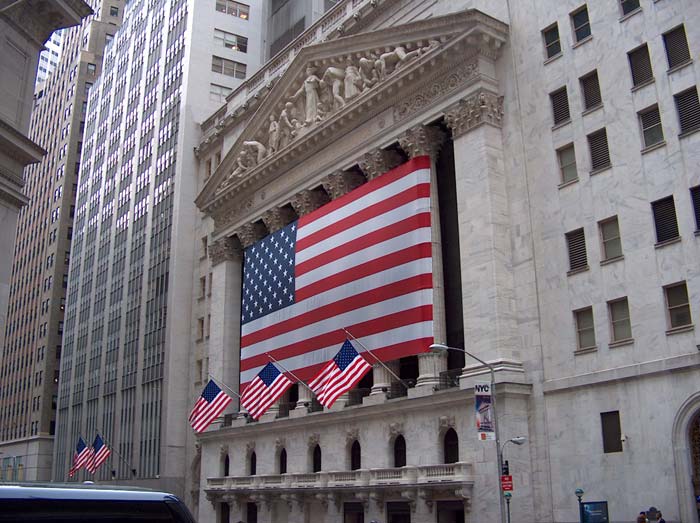
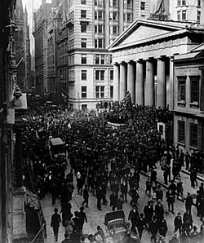
The Wall - protecting Colonists protecting Empire
In 1654, an early New Yorker named Peter Stuyvesant built a wall across lower Manhattan Island to protect Dutch colonists. Of course, New York wasnt a state at the time; the United States didnt even exist.
Today, the ancient wall is recalled by Wall Street, a short, narrow street in lower Manhattan that extends from Broadway to the East River.
Many of Americas stock-brokerage companies, banks and commodity exchanges are located on Wall Street or in the immediate neighborhood. Names associated with Wall Street include the New York Stock Exchange (NYSE), the NASDAQ, Merrill Lynch and Goldman Sachs.
|
|
|
The tremendous amount of money that flows through Wall Street has made it one of the most powerful areas in the world. When people talk about "Wall Street," theyre usually referring to an institution or an idea, rather than the street itself.
It could be said that the United States has two capitals. Washington, D.C. is its political capital, Wall Street its financial capital. It could also be argued that Wall Street is more powerful than the White House, since corporations now largely control the federal government.
Wall Street has also become increasingly synonymous with U.S. capitalism. It has lost a lot of prestige with the corporate crime wave that became even more frenzied after September 11.
http://www.geobop.com/symbols/911/1/index.htm
|
|
|
Bessemer- steel is power
In 1900, the Bessemer process accounted for twice as much U.S. steel as the open hearth: 7.4 million to 3.8 million tons. The Bessemer was the fastest melt shop of the twentieth century; steelmaking took 12 minutes. Using the violent reaction of oxygen in the air combining with the pig-iron carbon, Bessemer steelmaking "presents one of the most colorful of all steel processes, especially at night, when the blow resembles a spectacular fireworks display visible for many miles,"
inventors.about.com
|
|
|
|
Going down?
In 1852 the first hydraulic elevator was made by Elisha Graves Otis and was introduced one year later at the world exhibition in the Manhattan Crystal Palace. 1857 marked its first use in a building, the Haughwout Building in New York.
The most important invention for skyscrapers, however, was the steel skeleton, with that it was possible to build very tall buildings. The new thing about it was that the façade was now without any carrying function, it was like a second skin or shell. The steel skeleton made building more flexible and created more room on each level without any loss of the ground space. The expression the 'curtain wall' was used to refer to a façade made of light materials like aluminum, chrome or glass, which were used for the new facades of skyscrapers.
For a long time the Home Insurance Building in Chicago (1885) with its ten stories was considered to be the first skyscraper because it used the steel skeleton technique. However there were other buildings based on this technique before. For example, the steel skeleton technique had already been used in the Crystal Palace or in the Eiffel Tower. The first building which had a façade made entirely out of glass was the Hallidie Building by William Polks (1917). This would have never been possible to realize if the steel skeleton technique had not been invented.
thinkquest
|
|
The "invention" of the skyscraper
The "invention" of the skyscraper lies with George A. Fuller (1851-1900). George Fuller worked on solving the problems of the "load bearing capacities" of tall buildings. George Fuller built the Tacoma Building in 1889, the first structure ever built where the outside walls did not carrying the weight of the building. Using Bessemer steel beams, Fuller created steel cages that supported all the weight in tall buildings or skyscrapers. The Flatiron Building was one of New York City's first skyscrapers (Broadway and 23rd), built in 1902 by Fuller's building company. Daniel H. Burnham was the chief architect.
The term "skyscraper" was first used during the 1880s, shortly after the first 10 to 20 story buildings were built in the United States. Combining several innovations: steel structure, elevators, central heating, electrical plumbing pumps and the telephone, skyscrapers came to dominate American skylines at the turn of the century. The world's tallest building when it opened in 1913, architect Cass Gilbert's 793-foot Woolworth Building was considered a leading example of tall building design.
inventors.about.com
|
|
WTC
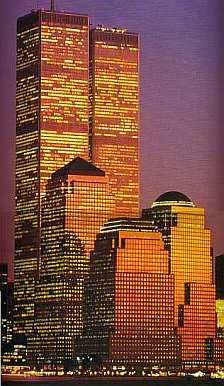
|
Business districts were being transformed by another architectural innovation, similarly the product of technological advances and artistic creation: the skyscraper. Beginning in the 1880s, architects and engineers in Chicago and New York began to experiment with new framing systems to achieve greater height, as well as an appropriate elevation for these taller buildingsat first only ten and then soon twenty stories high. The contrast among these buildings soon produced a new way of experiencing cities, captured in the term skyline, first used in Harper's in 1896 to describe Lower Manhattan. Louis H. Sullivan designed the most stunning compositions, clarifying a tripartite elevation, much like an enormous Greek column, and Daniel Burnham's name became synonymous with the corporate office, whereby scores of variations on a basic prototype were built in cities around the country.
At the turn of the century private business organizations prodded municipalities to build majestic civic centers. Washington, D.C., underwent such a change in 1902, epitomizing the fascination with comprehensive urban design. In San Francisco, Denver, Chicago, and dozens of other cities, large and small, the City Beautiful movement commissioned Beaux-Arts museums and libraries alongside new city halls for the governments espoused by progressive reformers.
lecture notes
the structures known as the World Trade Towers were influenced by religious considerations on the part of Yamasaki, the architect . Now it is time to more fully assert the idea: the Trade Tower was a structure whose purpose and design were almost entirely Buddhist.
http://www.designcommunity.com/scrapbook/1061.html
|
Though the idea of the World Trade Center was first proposed in 1946, just after World War II, for nearly fifteen years it would remain exactly that -- an idea. When the concept did re-emerge in the late 1950s, it would begin to move with an all but unstoppable force, propelled above all by two men, sons and brothers of one the most powerful family dynasties on earth.
Capitalist Internationalists
As much as anyone else of their time, David and Nelson Rockefeller embodied the potent mix of pragmatic capitalist drive and visionary internationalist outlook that underlay the new world order that America had put in place at the end of the war. More than anyone else, they took it upon themselves to ensure New York's role at the very center of that burgeoning commercial imperium.
Wealth and Power
Scions of the fortune established by their grandfather, the titan John D. Rockefeller -- who had built his company, Standard Oil, into one of the first and greatest international conglomerates in the world -- the two brothers had in the years since the war come to hold sway over an almost unimaginable concentration of wealth and power.
Headquarters City
Nelson, the second and most ambitious of John D. Rockefeller Jr.'s five sons, had begun his career in the Depression, helping his father transform midtown Manhattan through a spectacular office complex, Rockefeller Center, which became the supreme emblem of New York's new role as "headquarters city" for American corporations. In late 1946, when New York had seemed to be out of the running as the headquarters for the United Nations, Nelson had stepped in at the eleventh hour, with the help of his brother David, to ensure that the new world organization made its home in the city -- by arranging for the purchase of the East River site with $8.5 million of their father's money.
Banker-Statesman
David, the youngest and most determined of the brothers, had worked as an assistant to New York mayor Fiorello La Guardia before joining the international loan division of his family's bank, Chase, perhaps the most powerful financial institution in the world. By the mid-1950s, he was already becoming known as a "banker-statesman," who understood how to leverage financial resources to achieve larger political and diplomatic ends -- and how to leverage those ends, in turn, to amass more riches still.
Global Initiatives
From their offices on the 56th floor of 30 Rockefeller Plaza, the two brothers -- now taking over the reins of the family fortune from their father -- solidified their place at the very center of the East Coast power establishment. Nelson, preparing a bid for the governorship of New York State, exercised his passion for modern art and architecture by taking over leadership of his mother Abby Aldrich Rockefeller's project, the Museum of Modern Art, whose spectacular rise in the 1950s reflected the historic postwar shift of the art world from Paris to New York. David, meanwhile, rapidly ascending through Chase's upper ranks, embarked on an even larger initiative -- engineering a merger with the Bank of Manhattan to form Chase Manhattan, a financial colossus that would lead the way for American companies to transcend national boundaries and operate globally.
Lower Manhattan
Even as that expansion was getting under way, David turned his sights to a more pressing problem, much closer to home: the ailing fortunes of the old financial district around Wall Street, which was now threatening to unravel completely in the face of the postwar boom remaking its rival four miles to the north, midtown Manhattan. In November 1955, David boldly announced that Chase Manhattan would construct a new headquarters just one block north of Wall Street -- a sixty-story glass-and-steel tower rising from its own raised plaza that would represent the first major commercial construction in the district since the Depression.
The Big Idea
Concerned that even that bold gesture might not be enough to stem the exodus of business uptown, David next assembled a powerful coalition of business and real-estate leaders, called the Downtown-Lower Manhattan Association, to come up with a more sweeping proposal. At the center of the ambitious 550-block redevelopment program, released in 1959, would rise an updated version of the idea first floated more than a decade earlier -- one that would soon become David Rockefeller's most burning ambition: a World Trade Center.
Symbol of International Business
"David wanted to build an economic development entity," one aide later recalled, "that would also be a symbol of international business." "We don't want to compete with existing office space," the banker himself declared, defending the idea of the specialized, trade-related complex. "We want to provide some new use. A World Trade Center seems logical and it seems logical to have it near the banks that service the bulk of U.S. foreign trade."
Big, Bigger, Biggest
Like Rockefeller Center and Chase Manhattan before it, the complex would be an example of what David called "catalytic bigness" -- a project whose sheer size and impact would be large enough to provide the stimulus for further redevelopment. Indeed, the project David had in mind was so large and ambitious that it would require the resources of the state to bring it to fruition. As it happened, by January 1959 those resources were under the control of a new governor -- David's brother, Nelson -- who would soon take the lead in making his youngest sibling's vision a reality. In the years to come, as the project began rising over the skyline of Lower Manhattan, New Yorkers would give the immense twin towers a knowing nickname: David and Nelson.
PBS - People & Events:
|
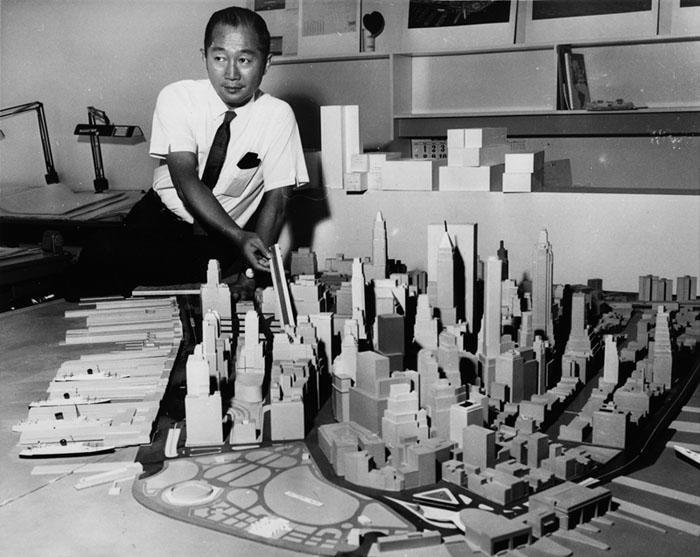 WTC
"The structural system, deriving from the I.B.M. Building in Seattle,
is impressively simple. The 208-foot wide facade is, in effect, a prefabricated steel lattice, with columns on 39-inch centers acting as wind bracing to resist all overturning forces; the central core takes only the gravity loads of the building. A very light, economical structure results by keeping the wind bracing in the most efficient place, the outside surface of the building, thus not transferring the forces through the floor membrane to the core, as in most curtain-wall structures. Office spaces will have no interior columns. In the upper floors there is as much as 40,000 square feet of office space per floor. The floor construction is of prefabricated trussed steel, only 33 inches in depth, that spans the full 60 feet to the core, and also acts as a diaphragm to stiffen the outside wall against lateral buckling forces from wind-load pressures.
|
|
The Creator's Words
"There are a few very influential architects who sincerely believe that all buildings must be 'strong'. The word 'strong' in this context seems to connote 'powerful' that is, each building should be a monument to the virility of our society. These architects look with derision upon attempts to build a friendly, more gentle kind of building. ... Although it is inevitable for architects who admire [the] great monumental buildings of Europe to strive for the quality most evident in them grandeur, the elements of mysticism and power, basic to cathedrals and palaces, are also incongruous today, because the buildings we build for our times are for a totally different purpose."
|
"I feel this way about it. World trade means world peace and consequently the World Trade Center buildings in New York ... had a bigger purpose than just to provide room for tenants. The World Trade Center is a living symbol of man's dedication to world peace ... beyond the compelling need to make this a monument to world peace, the World Trade Center should, because of its importance, become a representation of man's belief in humanity, his need for individual dignity, his beliefs in the cooperation of men, and through cooperation, his ability to find greatness."
Minoru Yamasaki
greatbuildings.com
|
|
WTC Facts
More than 1.2 million cubic yards of earth and rock were excavated to make way for the World Trade Center. The excavated material was placed in the Hudson River to create 23.5 acres of new land deeded to the City of New York. This landfill area is now Battery Park City.
More than 200,000 tons of steel, far more than the amount required for the construction of the Verrazano Narrows Bridge, was used in the World Trade Center's construction.
The 425,000 cubic yards of concrete used in building the World Trade Center is enough to build a five-foot wide sidewalk from New York City to Washington, D.C.
At peak periods of construction, some 3,500 workers were on the site daily.
There were 43,600 windows in the Twin Towers with over 600,000 square feet of glass window area cleaned by automatic window washing machines traveling on stainless steel tracks.
With 60,000 tons of cooling capacity, the World Trade Center's refrigeration plant was the largest in the world.
The 360-foot television mast atop One World Trade Center supported 10 main television antennas, numerous auxiliary antennas and a master FM antenna. Transmissions from the mast began in June, 1980. Ten television stations in the metropolitan area, including all the major networks, broadcast from the mast. In addition, six stations broadcasted high-definition, digital television from the World Trade Center.
The Tower's skylobby elevator systems separated express from local runs. There were 239 elevators and 71 escalators in the four buildings operated by the Port Authority at the complex. The sky lobby express elevators were capable of carrying 55 people, a 10,000 pound capacity. Express elevators can travel at speeds of up to 27 feet per second. - september-11th.us
|
|
|
Towers of the new gods
In Tuans view, Washington DC is a modern example of the ideal city. So is Brasilia, the capital of Brazil, which planners and architects set about building from scratch in the 1950s. Its cruciform shape is said to suggest a bird or a plane, poised for takeoff on what otherwise is an empty expanse far from Brazils populated coast. Tuan sees the futuristic Brasilia as a symbol both of modern Brazils collective ego and of an enduring primal desire to bridge the distance between the human earth and the superhuman sky.1
The art historian Robert Hughes looks more harshly on Brasilia as a vast example of what happens when people design for an imagined future, rather than for a real world, He calls it an expensive and ugly testimony to what gets built when men think in terms of abstract space rather than real space, of single rather than multiple meanings, and of political aspirations instead of human needs. He traces this failure back through Brasilias principal architects, Lucio Costa and Oscar Niemeyer, to their mentor Le Corbusier, who is perhaps the only figure to surpass Mies van der Rohe in his influence on twentieth-century architecture. Both were prominent in the so-called International Style, which gave the world the now ubiquitous glass box skyscraper and Le Corbusiers dubious ideals for urban planning, known as The Functional City.
Hughes argues that modernist architecture, like much of modernist art in general, was value-free and could serve almost any ideological interest. The same could be said of the age-old desire to build up and to build big. Thus the Russian constructivist Vladimir Tatlin could design, in 1920, a giant revolving monument taller than the Eiffel Tower to honor the socialist utopia that supposedly began with the Russian Revolution, It was never built, Nazi architect Albert Speer envisioned a mammoth dome in Berlin to honor Hitlers Thousand Year Reich. It was never built either. Whenever such plans are realized - as in Brasilia - the results tend to be the same. Hughes calls it an architecture of coercion that physically reiterates the individuals symbolic nothingness compared to the looming power of the state.
Brasilia marks the end of an era. What lies beyond Brasilia - some call it post-modernism - is a transitional period in which the builder-heroes like Mies, Walter Gropius and Le Corbusier no longer dominate the architectural imagination. Meanwhile, the architects, like artists in many other fields, wait for the new paradigms and manifestoes that will energize them.
The World Trade Center, designed by Minoru Yamasaki (with help from Emery Roth and Sons), belongs to this interim. While obviously related to the modernist box, the towers also recall earlier technical and aesthetic strategies. Their weight, for one thing, is carried by their aluminum skins rather than hung in Miesian fashion from a steel skeleton. In appearance, these high-tech surfaces echo the tracery that adorns the Gothic cathedrals - a conscious borrowing from the past that a high modernist would no doubt have resisted.
http://www.newint.org/issue202/towers.htm
|
|
|
Symbolic nature of the tower....
The Pythagorean Tarot card
The tower is ambiguous: is it a fortress or a prison? Indeed there is little difference, for we easily may become prisoners of our own defenses.
The tower is the World Axis, the center of being, and the divine illumination has struck at its core, demolishing it, but igniting in its depths the spark of new life. The falling figures, representing head and heart (reason and emotion), were imprisoned in the tower's dogma and defenses. Though now released, before they can be reborn they must "come back to the earth" of the body and must be submerged in the Abyssal waters of the unconscious, which have been quickened by the lightning. The manna from heaven, falling around them, will sustain them through the trials of this transformation.
http://www.cs.utk.edu/~mclennan/BA/PT/M15.html
|
Wall street was a divide barrier against the 'savagery'
of the aggressor
WTC is a symbol of a corporate superhuman phallus
'Members of the board' are closer to the sky - God - Ra.
are at the top of the Masonic pyramid - obelisk
separated from the mortal - savage 'ground dwellers'
The WTC was brought down deliberately
as a symbol of savagery attacking civilization
|
Speaking in a ballroom just a few miles north of ground zero, Karl Rove said the Democratic party did not understand the consequences of the Sept. 11, 2001, attacks.
"Liberals saw the savagery of the 9/11 attacks and wanted to prepare indictments and offer therapy and understanding for our attackers,"
"Conservatives saw the savagery of 9/11 and the attacks and prepared for war."
msnbc
|
Islam were implicated as the new savages of the 21st century...
Final irony?
|
|
Bin Laden construction group builds skyscrapers
The Bin Laden Construction group recently won a bid to build the tallest skyscraper in the world in Dubai, United Arab Emirates (UAE). The announcement made front-page news in most major Arab media outlets, including the Arab News, the Gulf News and the pan-Arab daily Asharq al-Awsat.
According to Asharq al-Awsat, the building will be over 2,300 feet high, with 160 floors in addition to a parking garage and the ground floor. The Bin Laden skyscraper will outstrip by more than 820 feet the current contender, Petronas Towers in Kuala Lumpur, Malaysia, and will house a hotel wing, apartments, offices, entertainment centers and restaurants, according to the report.
The project is intended to show the world the extent of the Bin Laden group's financial and engineering abilities: They will handle all aspects of the building, from financing to construction, on their own. Any large company wants to be seen flexing its industrial and commercial muscle. But the powerful images of 9/11 may give the project its own symbolic meaning.
alternet.org
|
|
